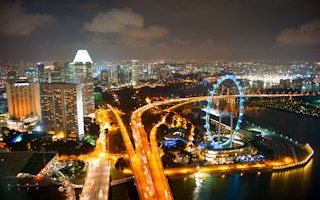Singapore on Friday committed to reduce the carbon emissions it emits per GDP dollar by 36 per cent from 2005 levels by 2030, with the aim of peaking its emissions by that time.
To continue reading, subscribe to Eco‑Business.
There's something for everyone. We offer a range of subscription plans.
- Access our stories and receive our Insights Weekly newsletter with the free EB Member plan.
- Unlock unlimited access to our content and archive with EB Circle.
- Publish your content with EB Premium.
Although the city state’s plan to reduce emissions intensity will still see its absolute emissions rising from about 46.8 million tonnes in 2010 to about 65 million tonnes by 2030, the commitment is a “stretch target”, said NCCS.
This was because Singapore had already taken many early steps to reduce its emissions - such as switching from oil to natural gas as its power source.
It submitted its ‘Intended Nationally Determined Contribution’ or INDC in United Nations climate negotiation jargon to the UN on Friday, joining a string of countries such as China, United States, Korea, Mexico, and Canada that have recently made pledges ahead of a highly anticipated meeting at year-end in Paris.
The world’s 195 nations are meant to ink a global treaty on climate change then.
Singapore, which accounts for 0.11 per cent of global emissions, said it will reduce its emissions intensity, or emissions emitted per dollar of gross domestic product (GDP), which will see it drop from 0.176 kg of carbon emissions equivalent per dollar of GDP in 2005 to 0.113 kg in 2030.
Its absolute emissions will peak at 65 million tonnes around 2030, said the NCCS.
Singapore’s announcement closely follows that of China earlier in the week, which pledged to peak its greenhouse emissions by 2030, and ‘work hard’ to do so even earlier. It also aims to reduce its emissions intensity by up to 65 per cent, meet 20 per cent of its energy consumption with renewable energy, and increase its forest stock.
UNFCCC will collate all INDCs submitted by October, and report on the estmated total reductions in November.
The country’s deputy prime minister and head of its multi-ministry climate change committee, Teo Chee Hean, said in a statement: “For a very small country with limited alternative energy options, the stabilisation of our emissions with the aim of peaking around 2030 requires serious effort by everyone.”
Michael Quah, professor at the National University of Singapore’s department of chemical and biomolecular engineering, told Eco-Business that reducing absolute emissions is a more reasonable target for countries whose economies are static or shrinking.
But in developing countries, energy intensity puts the focus on sustainable growth, he said. This is because it allows emerging economies to grow their wealth, but puts pressure on them to do so with a minimum increase in energy consumption.
Singapore is listed as a non-Annex I country in the UNFCCC framework, a classification which mostly comprises developing countries and nations which are especially vulnerable to the impact of climate change. Annex I countries on the other hand, are developed and industrialised states.
“
For a very small country with limited alternative energy options, the stabilisation of our emissions with the aim of peaking around 2030 requires serious effort by everyone.
Teo Chee Hean, deputy prime minister of Singapore
It is also a more transparent indicator than pegging reductions against business-as-usual (BAU) levels, which project future emissions if no action is taken to reduce them, said Quah.
Countries can make high BAU projections so that larger reductions are easier to achieve, but emissions intensity involves comparing two fixed figures to track progress.
Singapore’s INDC was finalised after the government conducted extensive consultation within its various ministries, worked with academic and industry experts, and held a public consultation exercise, said NCCS.
These consultations showed that improving energy efficiency was a key strategy to help Singapore’s power, buildings, households, industry, and transport sectors reduce emissions even further.
Increasing public transport use, promoting energy-saving behaviour, and increasing the use of solar energy were among other suggestions.
The INDC submission builds on a commitment made by Singapore in 2009 to reduce emissions by seven to 11 per cent below 2020 BAU levels regardless of whether there is a global agreement on reducing emissions. If such a agreement is inked, Singapore would raise its emissions cuts to 16 per cent.
The country projected that in the BAU scenario, it would be putting 77 million tonnes of carbon dioxide annually into the atmosphere by 2020, an increase of 30 million tonnes from 2010’s emissions.
The government’s specific plans to cap this rise in emissions at 65 million tonnes will be announced at a later date, said NCCS.
The strategy will build on existing national policies such as a sustainability certification for buildings and mandatory energy management for large companies.
“The government will continue to seek feedback on new measures before they are introduced,” added NCCS. “Sufficient lead time will be given to businesses and households to adjust to the new requirements.”
Quah also said that Singapore’s target of reducing emissions intensity by 36 per cent is “ambitious”, because major changes such as switching from oil to natural gas have already been made.
“Singapore will have to be more creative in finding new ways to cut their emissions now,” he said. Industrial energy efficiency is an area that has significant potential to deliver reductions, and if “buildings, transport, and the household sector chip in, they can do it,” he said
And as Singapore pursues a low-carbon economy, there are opportunities to be reaped as well, said Deputy Prime Minister Teo.
“The climate challenge also means greater global demand for clean technology and growth in green jobs,” he pointed out.
Singapore’s early adoption of energy responsible practices and its investment in research and development “provides a strong foundation for us to pro-actively respond to the challenge of climate change and opportunities it offers,” he added.










